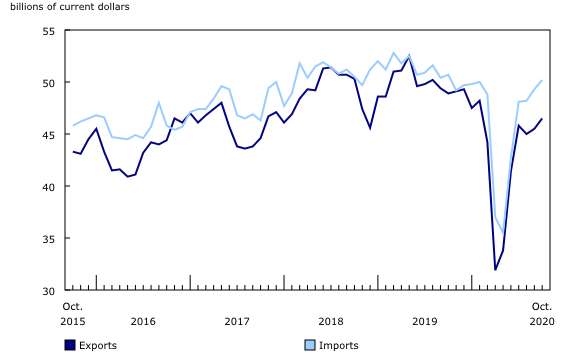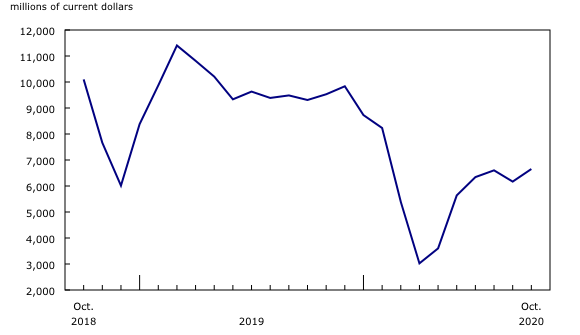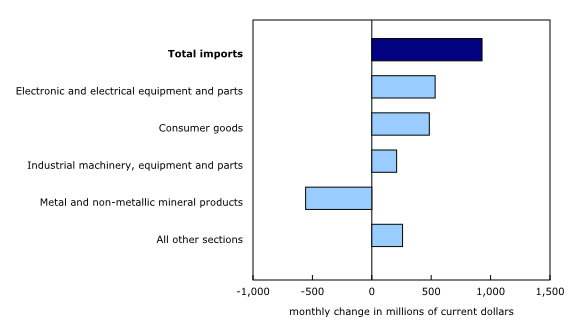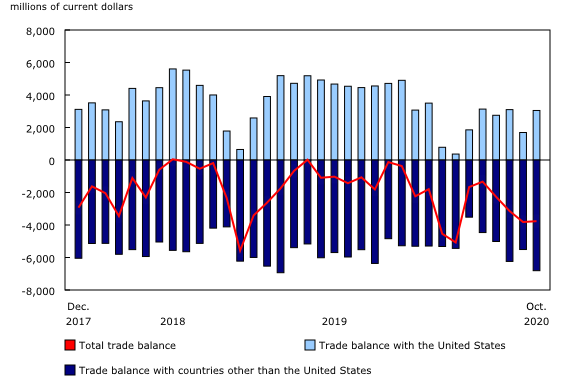Canadian international merchandise trade, October 2020
Archived Content
Information identified as archived is provided for reference, research or recordkeeping purposes. It is not subject to the Government of Canada Web Standards and has not been altered or updated since it was archived. Please "contact us" to request a format other than those available.
Released: 2020-12-04
In October, Canada's merchandise exports increased 2.2%, partially on higher exports of pharmaceutical products. Imports rose 1.9%, in part due to higher imports of cell phones. As a result, Canada's merchandise trade deficit with the world was virtually unchanged at $3.8 billion in October.
To explore the most recent results from Canada's international merchandise trade in an interactive format, see the new "International merchandise trade monthly interactive dashboard."
Exports of pharmaceutical products rebound
Total exports rose 2.2% to $46.5 billion in October, which was $1.7 billion below the level posted in February. In October, 8 of 11 product sections increased, and non-energy exports were up 1.3%. In real (or volume) terms, total exports rose 1.2%.
After a sharp 6.2% decrease in September, exports of consumer goods rose 10.2% to $6.3 billion in October. This was driven by a rebound in exports of pharmaceutical products (+39.0%), which declined 28.2% in September on lower exports to the United States of medication used to treat depressive disorders. However, in October, exports to the United States of medication for treating different forms of psoriasis offset the drop in September.
Exports of energy products rose 7.8% to $6.7 billion, led by higher exports of crude oil (+4.6%) and natural gas (+26.7%). Both crude oil and natural gas exports saw gains in volumes and prices in October. Despite this growth, exports of energy products were down 19.2% compared with February.
These increases were partially offset by a decline in exports of motor vehicles and parts (-4.7%). Exports of passenger cars and light trucks fell 6.8% to $4.8 billion in October, partly on a slowdown in production, as automotive assembly plants adjusted to demand. Despite the monthly decline, export of passenger cars and light trucks in October were higher than in February.
Imports of cellphones and clothing, footwear and accessories follow an atypical trend
Total imports were up 1.9% to $50.2 billion, exceeding the February level for the first time since the COVID-19 pandemic began. Of the 11 product sections, 7 increased. In real (or volume) terms, imports rose 1.7%.
Imports of electronic and electrical equipment and parts (+9.5%) contributed the most to the increase in imports. Following a 37.8% decrease in September, imports of communication, and audio and video equipment—a category consisting largely of cell phones—rebounded 41.3% in October. As mentioned in the September publication, the pandemic drove the cell phone industry to introduce new models outside the typical release cycle. The introduction of new models in Canada in October rather than September, the usual month for new releases, accounts for this strong increase. Despite the gain in October, imports of communication, and audio and video equipment were down 17.4% since the beginning of the year compared with the same period in 2019.
Imports of consumer goods, the largest product section for Canadian imports, rose 4.3% to a record $11.6 billion in October. Imports of clothing, footwear and accessories (+22.0%), which posted an atypical movement for the month of October, contributed the most to the gain. However, for the January to October period, imports of clothing, footwear and accessories were down 21.9% in 2020 compared with 2019. Meanwhile, imports of appliances (+21.2%) also increased in October.
These gains were partly offset by lower imports of metal and non-metallic mineral products (-12.4%). Imports of unwrought gold, silver and platinum group metals, and their alloys (-38.7%) contributed the most to this drop, mainly on lower imports of gold and silver. Despite this monthly decline, imports in this product group reached record levels in 2020. For the year to date, these imports are almost five times higher than in the same period in 2019.
Trade rises with non-US countries, but stagnates with the United States
Since the sharp gains in July, trade with countries other than the United States has trended differently than trade with the United States. Combining exports and imports, total trade with the United States in October was 0.3% below July levels. Meanwhile, total trade with countries other than the United States not only posted smaller losses in the spring, it has also risen 10.6% since July.
In October, imports (+9.1%) and exports (+2.7%) with countries other than the United States rose again. It was the fifth consecutive monthly increase for imports and a fourth increase in the last five months for exports.
China (cell phones and various products) and South Korea (various products) posted the largest increases in imports, while the United Kingdom (gold and crude oil) and the Netherlands (oilseeds) contributed the most to growth in exports. Canada's trade deficit with countries other than the United States widened from $5.5 billion in September to $6.8 billion in October.
Exports to the United States rose 2.0% in October, while imports fell 2.3%. As a result, Canada's trade surplus with the United States widened from $1.7 billion in September to $3.0 billion in October.
When the average exchange rates of September and October are compared, the Canadian dollar was stable relative to American dollar.
Revisions to September merchandise exports and imports data
Imports in September, originally reported as $48.8 billion in the previous release, were revised to $49.3 billion in the current month's release. Exports in September, originally reported at $45.5 billion in the previous release, were essentially unchanged in the current month's release.
Trade in medical and protective goods
In October, imports of medical and protective goods decreased for a second consecutive month, down 3.6% to $3.0 billion on a customs basis. The largest declines were observed in imports of diagnostic products (-11.8%), personal protective equipment (-5.2%), and medical equipment and products (-0.4%). Higher imports of disinfectant and sterilization products (+5.4%) moderated these declines. Year over year, imports of medical and protective goods were up 29.8%. Meanwhile, exports of medical and protective goods rose 18.1% to $1.5 billion in October. Higher exports of medical equipment and products (+29.0%) this month followed a decrease in September.
Monthly trade in services
In October, monthly service exports were up 1.9% to $9.3 billion, and service imports increased 1.7% to $9.4 billion.
When international trade in goods and services are combined, exports increased 2.1% to $55.8 billion in October, while imports rose 1.9% to $59.6 billion. As a result, Canada's trade deficit with the world for goods and services combined was $3.8 billion in October.
Note to readers
Merchandise trade is one component of Canada's international balance of payments (BOP), which also includes trade in services, investment income, current transfers, and capital and financial flows.
International trade data by commodity are available on both a BOP and customs basis. International trade data by country are available on a customs basis for all countries, and on a BOP basis for Canada's 27 principal trading partners (PTPs). The list of PTPs is based on their annual share of total merchandise trade—imports and exports—with Canada in 2012. BOP data are derived from customs data by adjusting for factors such as valuation, coverage, timing and residency. These adjustments are made to conform to the concepts and definitions of the Canadian System of National Accounts.
For a conceptual analysis of BOP-based data versus customs-based data, see "Balance of Payments trade in goods at Statistics Canada: Expanding geographic detail to 27 principal trading partners."
For more information on these and other macroeconomic concepts, see the Methodological Guide: Canadian System of Macroeconomic Accounts (13-607-X) and the User Guide: Canadian System of Macroeconomic Accounts (13-606-G).
The data in this release are on a BOP basis and are seasonally adjusted. Unless otherwise stated, values are expressed in nominal terms, or current dollars. References to prices are based on aggregate Paasche (current-weighted) price indexes (2012=100). Movements within aggregate Paasche prices can be influenced by changes in the share of values traded for specific goods, with sudden shifts in trading patterns—as observed currently with the pandemic—sometimes resulting in large movements in Paasche price indexes. Volumes, or constant dollars, are calculated using the Laspeyres formula (2012=100), unless otherwise stated.
For information on seasonal adjustment, see Seasonally adjusted data – Frequently asked questions.
Revisions
In general, merchandise trade data are revised on an ongoing basis for each month of the current year. Current-year revisions are reflected in both the customs-based and BOP-based data.
The previous year's customs-based data are revised with the release of data for the January and February reference months, and thereafter on a quarterly basis. The previous two years of customs-based data are revised annually, and revisions are released in February with the December reference month.
The previous year's BOP-based data are revised with the release of data for the January, February, March and April reference months. To remain consistent with the Canadian System of Macroeconomic Accounts, revisions to BOP-based data for previous years are released annually in December with the October reference month.
Factors influencing revisions include the late receipt of import and export documentation, incorrect information on customs forms, the replacement of estimates produced for the energy section with actual figures, changes in merchandise classification based on more current information, and changes to seasonal adjustment factors.
For information on data revisions for exports of energy products, see Methodology for Exports of Energy Products within the International Merchandise Trade Program.
Revised data are available in the appropriate tables.
Real-time data table
The real-time data table 12-10-0120-01 will be updated on December 21.
Next release
Data on Canadian international merchandise trade for November 2020 will be released on January 7, 2021.
Products
The product International merchandise trade monthly interactive dashboard (71-607-X) is now available. This new interactive dashboard is a comprehensive analytical tool that presents monthly changes in Canada's international merchandise trade data on a balance of payments basis, fully supporting the information presented every month in the Daily text.
The product The International Trade Explorer (71-607-X) is now available online.
Customs-based data are now available in the Canadian International Merchandise Trade Database (65F0013X).
The updated Canada and the World Statistics Hub (13-609-X) is now available online. This product illustrates the nature and extent of Canada's economic and financial relationship with the world using interactive graphs and tables. This product provides easy access to information on trade, investment, employment and travel between Canada and a number of countries, including the United States, the United Kingdom, Mexico, China, Japan, Belgium, Italy, the Netherlands and Spain.
Contact information
For more information, contact us (toll-free 1-800-263-1136; 514-283-8300; STATCAN.infostats-infostats.STATCAN@canada.ca).
To enquire about the concepts, methods or data quality of this release, contact Benoît Carrière (613-415-5305; benoit.carriere@canada.ca), International Accounts and Trade Division.
- Date modified:









